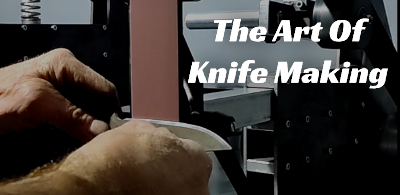The Enthralling Journey of Knife Making
Have you ever held a beautifully crafted knife in your hand, gazed at its polished surface, and found yourself awestruck at the sheer elegance and craftsmanship it displayed? Knife making, an intriguing blend of artistry, scientific precision, and practical functionality, has fascinated humans since the dawn of civilization. If you've found yourself wondering how to start knife making, let this guide serve as your first step into this beguiling world.
Choosing Your Materials: The First Key Decision
Any journey starts with a single step, and in knife making, that first step is choosing the right material. The most common materials used are carbon steel and stainless steel, each with its unique advantages and disadvantages. Carbon steel, praised for its capacity to be sharpened to a razor's edge and its remarkable edge retention, is susceptible to rust. Stainless steel, conversely, is rust-resistant, but it may not hold an edge as well as its carbon counterpart. Consider your end goal: if you desire a hardworking tool, carbon steel may be your go-to; if aesthetic and rust resistance are your priorities, stainless steel might win your favor.
Want to read more about choosing your knife materials? Check out our basic tool selection guide by clicking here.
Essential Tools: The Knife Maker’s Trusty Companions
Just as a writer needs a pen and paper, a knife maker requires tools. Your workshop should house a forge or kiln for heating your chosen material, a hammer for shaping, an anvil as a sturdy surface to work on, and files for refining the shape of your blade. If you see knife making as a long-term pursuit, consider investing in a belt grinder for efficient shaping and sharpening. Remember that your skill as a craftsman is what truly matters, not the sophistication of your tools.
Want to read more about knife making tools? Check out our in-depth guide by clicking here.
Understanding Blade Designs: Form Following Function
The diversity in blade designs is a testament to the unique needs and uses of these tools across various cultures and occupations. The blade of a chef's knife is designed differently from that of a hunting knife, and for good reason. Learning about different blade designs will help you understand the purpose each knife serves, allowing you to design your own blade with a specific function in mind. Research extensively, sketch your designs, and don't be afraid to experiment.
Need to delve deeper into blade design? Read our “Blade Design – The Beginning of a Journey” article by clicking here!
The Crafting Process: Turning Raw Material into Art
Here, we arrive at the heart of knife making: the crafting process. This process is a dance of science and art, requiring both technical knowledge and artistic flair. Begin by forging your material, heating it in your forge or kiln, and shaping it with your hammer and anvil. Once you've achieved a rough shape, anneal the steel, letting it cool slowly to soften it for detailed shaping. Grind your blade to form the edge, keeping in mind the knife's intended use and the required sharpness. Finally, harden the blade through heat treatment, a critical step that imbues your knife with strength and durability.
Finishing Touches: Personality and Polish
After crafting the blade, it's time for the details that make your knife truly yours. The handle, a crucial part of any knife, should be both aesthetically pleasing and comfortable to hold. Choose materials that appeal to you and complement your blade, such as wood, bone, or even hand-cast resin. Polish your blade to your desired finish, whether that's a mirror-like shine or a rustic, hand-forged look. You can even add personalized engravings, a feature that can transform your knife from a mere tool into a treasured heirloom.
The Reward of the Craft
The road to becoming a knife maker is paved with patience, persistence, and a profound respect for the ancient tradition of this craft. It's not merely about producing a tool; it's about breathing life into an inanimate piece of metal, transforming it into a functional work of art. The satisfaction derived from seeing a piece of steel morph into a blade under your hands is second to none.
As you delve deeper into this craft, you'll find yourself developing not just a new skill but a heightened sense of appreciation for the marriage of form and function. The blade you craft will be more than just a knife; it will be a tangible testament to your dedication and hard work, an object bearing the unique stamp of your personality.
Knife making is an art form that's as old as civilization itself. By choosing to embark on this journey, you're not just making a knife; you're taking your place in the long lineage of artisans who've dedicated themselves to this craft. You're becoming a part of a tradition that's been handed down through generations, a tradition that marries utility with beauty, practicality with creativity.
So, for those who are ready to take the plunge and learn how to start knife making, remember this: cherish each step of the journey, from the selection of materials to the final polish. Let the process shape you just as you shape the metal. Let your creations be a testament to your journey, a reflection of your dedication, and a symbol of your place in the grand tapestry of this timeless craft.
